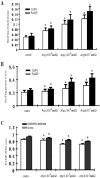The effect of adrenomedullin and proadrenomedullin N-terminal 20 peptide on angiotensin II induced vascular smooth muscle cell proliferation
- PMID: 27096064
- PMCID: PMC4823616
The effect of adrenomedullin and proadrenomedullin N-terminal 20 peptide on angiotensin II induced vascular smooth muscle cell proliferation
Abstract
Objectives: The study aimed to investigate the effects of adrenomedullin (ADM) and proadrenomedullin N- terminal 20 peptide (PAMP) on angiotensin (AngII)-stimulated proliferation in vascular smooth muscle cells (VSMCs).
Materials and methods: Thoracic aorta was obtained from Wistar rats and VSMCs were isolated from aorta tissues and then cultured. In vitro cultured VSMCs were stimulated with Ang II (10(-8) mol/l) followed by various doses of PAMP or ADM (10(-9), 10(-8), or 10(-7) mol/l). Cell proliferation as assessed by (3)H-TdR incorporation. Protein kinase C (PKC) activity was measured by counting γ-(32)P radioactivity with liquid scintillation. In a separate cohort, in vitro cultured rat aortic vessels were treated with different doses of Ang II or PAMP (10(-9), 10(-8), or 10(-7) mol/l). Cellular and secreted levels of PAMP, ADM and Ang II were measured using radioimmunoassay in the tissues and intubation mediums, respectively.
Results: Ang II (10(-8) mol/l) treatment significantly increased both (3)H-TdR incorporation and PKC activity in VSMCs (by 2.68 and 1.02-fold, respectively; both P<0.01 vs. the control). However, Ang II-induced elevation of (3)H-TdR incorporation, and PKC activity was significantly inhibited by various doses of ADM and PAMP (all P<0.01 vs. the Ang II group). In rat aortic vascular tissues or intubation media, Ang II treatments stimulated the expression and secretion of PAMP and ADM in a dose-dependent manner, while PAMP treatments had no significant effects on Ang II levels.
Conclusion: ADM and PAMP inhibit Ang II-induced VSMCs proliferation. The interaction of Ang II, ADM and PAMP may regulate VSMCs and cardiovascular function.
Keywords: Adrenomedulin; Angiotension II; Proadrenomedullin N-terminal 20 peptide; Proliferation; Vascular smooth muscle-cell.
Figures


Similar articles
-
Proadrenomedullin N-terminal 20 peptide inhibits aldosterone secretion of human adrenocortical and Conn's adenoma cells: comparison with adrenomedullin effect.J Clin Endocrinol Metab. 1998 Jan;83(1):253-7. doi: 10.1210/jcem.83.1.4517. J Clin Endocrinol Metab. 1998. PMID: 9435451
-
Desensitization of adrenomedullin and calcitonin gene-related peptide receptors in vascular smooth muscle cells--effects of receptor activity-modifying protein.Sheng Li Xue Bao. 2001 Oct;53(5):396-400. Sheng Li Xue Bao. 2001. PMID: 11833426
-
[Effects of peptides originated from the proadrenomedullin on the production of nitric oxide in rat aorta].Beijing Da Xue Xue Bao Yi Xue Ban. 2003 Apr 18;35(2):146-9. Beijing Da Xue Xue Bao Yi Xue Ban. 2003. PMID: 12920830 Chinese.
-
Proadrenomedullin-derived peptides in the paracrine control of the hypothalamo-pituitary-adrenal axis.Int Rev Cytol. 2001;206:249-84. doi: 10.1016/s0074-7696(01)06024-7. Int Rev Cytol. 2001. PMID: 11407762 Review.
-
Role of adrenomedullin and related peptides in the regulation of the hypothalamo-pituitary-adrenal axis.Peptides. 1997;18(7):1079-89. doi: 10.1016/s0196-9781(97)00046-6. Peptides. 1997. PMID: 9357070 Review.
Cited by
-
Extracellular Vesicles Mediate Communication between Endothelial and Vascular Smooth Muscle Cells.Int J Mol Sci. 2021 Dec 28;23(1):331. doi: 10.3390/ijms23010331. Int J Mol Sci. 2021. PMID: 35008757 Free PMC article.
-
Rab7‑mediated autophagy regulates phenotypic transformation and behavior of smooth muscle cells via the Ras/Raf/MEK/ERK signaling pathway in human aortic dissection.Mol Med Rep. 2019 Apr;19(4):3105-3113. doi: 10.3892/mmr.2019.9955. Epub 2019 Feb 14. Mol Med Rep. 2019. PMID: 30816458 Free PMC article.
-
Hypoxia-inducible factor 1a induces phenotype switch of human aortic vascular smooth muscle cell through PI3K/AKT/AEG-1 signaling.Oncotarget. 2017 May 16;8(20):33343-33352. doi: 10.18632/oncotarget.16448. Oncotarget. 2017. PMID: 28415624 Free PMC article.
-
Gene expression profiles and signaling mechanisms in α2B-adrenoceptor-evoked proliferation of vascular smooth muscle cells.BMC Syst Biol. 2017 Jun 28;11(1):65. doi: 10.1186/s12918-017-0439-8. BMC Syst Biol. 2017. PMID: 28659168 Free PMC article.
-
Uremic Toxins and Vascular Calcification-Missing the Forest for All the Trees.Toxins (Basel). 2020 Sep 29;12(10):624. doi: 10.3390/toxins12100624. Toxins (Basel). 2020. PMID: 33003628 Free PMC article. Review.
References
-
- Nishikimi T, Kuwahara K, Nakagawa Y, Kangawa K, Nakao K. Adrenomedullin in cardiovascular diseases: a useful biomarker, its pathological roles and therapeutic application. Curr Protein Pept Sci. 2013;14:256–67. - PubMed
-
- Hirata Y, Takagi Y, Takata S, Fukuda Y, Yoshimi H, Fujita T. Calcitonin gene-related peptide receptor in cultured vascular smooth muscle and endothelial cells. Biochem Biophys Res Commun. 1988;151:1113–1121. - PubMed
-
- Haller H, Baur E, Quass P, Behrend M, Lindschau C, Distler A, et al. High glucose concentrations and protein kinase C isoforms in vascular smooth muscle cells. Kidney Int. 1995;47:1057–1067. - PubMed
-
- Shimosawa T, Fujita T. Hypotensive effect of a newly identified peptide, proadrenomedullin N-terminal 20 peptide. Hypertension. 1996;28:325–329. - PubMed
-
- Sugo S, Minamino N, Kangawa K, Miyamoto K, Kitamura K, Sakata J, et al. Endothelial cells actively synthesize and secrete adrenomedullin. Biochem Biophys Res Commun. 1994;201:1160–1166. - PubMed
LinkOut - more resources
Full Text Sources
Miscellaneous
